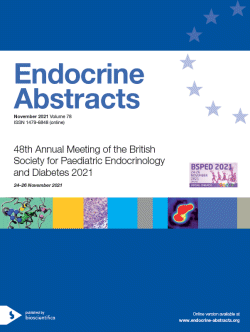
48th Meeting of the British Society for Paediatric Endocrinology and Diabetes
Online,
Virtual
24 Nov 2021 - 26 Nov 2021

Poster Presentations
Miscellaneous
ea0078p40 | Miscellaneous | BSPED2021
Can playing a computer game assess muscle function? Using ability captured through interactive video evaluation (ACTIVE) in duchenne muscular dystrophy
McElvaney Joseph , Wood Claire , Hollingsworth Kieren G , Hughes Eric , Muni Lofra Robert , Mayhew Anna , Sodhi Jassi , James Meredith , Cheetham Tim , Straub Volker
ea0078p41 | Miscellaneous | BSPED2021
Paediatric society calls for a review of access to funding for continuous glucose monitoring systems for patients with recurrent hypoglycaemia
May Ng Sze , Mushtaq Talat , Randell Tabitha
ea0078p42 | Miscellaneous | BSPED2021
A rare case of steroid cell tumor, not otherwise specified (NOS) of the ovary presenting with cushing syndrome and hyperandrogenism
Rani Rai Versha , Noor Ibrahim Mohsina , Raza Jamal , Muhammad Laghari Taj , Khoso Zubair , Riaz Maira
ea0078p43 | Miscellaneous | BSPED2021
Hypoglycaemia in paediatrics – Re-Audit post introduction of “Hypo Packs”
Longley Catherine , Bruce Marnie , Patel Harsita , Rangasami Jayanti
ea0078p44 | Miscellaneous | BSPED2021
Interpretation of CGM-measured nocturnal hypoglycaemia in congenital hyperinsulinism
Yang Leyi , Worth Chris , Salomon Estebanez Maria , O‘Shea Elaine , Banerjee Indi
ea0078p45 | Miscellaneous | BSPED2021
Heterozygous mutations in ATP-sensitive potassium channel (KATP) genes associated with transient and mild hyperinsulinaemic hypoglycaemia
Siese Thomas , Alins-Sahun Yolanda , Crowne Elizabeth , Giri Dinesh



